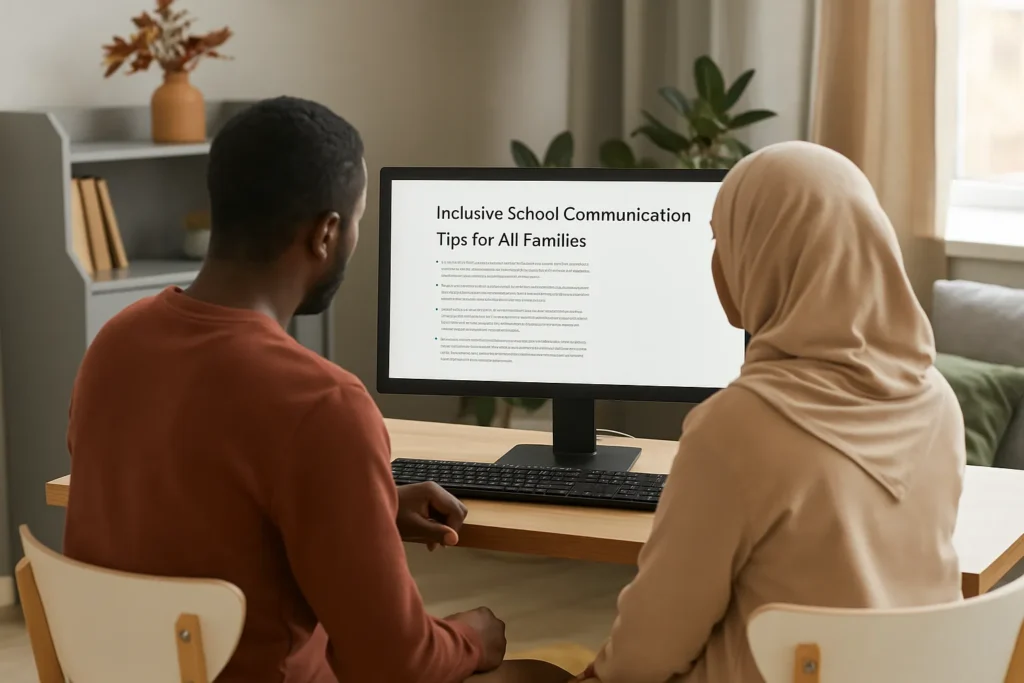Parent-teacher communication can be stressful for both parties involved. As a teacher, you want to support students, but miscommunications, cultural differences, or unresponsive families can add more to the stress.
It’s easy to get discouraged. But building trust and connection with families starts with small, consistent actions.
In this guide, we’ll break down practical ways to strengthen teacher family relationships, making your job (and your child’s success) a whole lot easier.
And it all starts with trust.
Building Trust with Families: Your First Step to Better Communication
Ever notice how easy conversations feel when there’s trust? It’s the same in parent-teacher communication. But for many families, schools can feel overwhelming or unfamiliar. They might not know when to reach out or what to expect from teachers.
So you need to set the tone early and build genuine connections with families through small, simple actions.

Here are a few easy ways to start building trust with your student’s family:
Show Up Consistently
Building strong parent-teacher communication starts with being present. Even if it’s a quick chat in the hallway or a scheduled parent meeting, give families your full attention. Put your phone away, close your laptop, and focus on the conversation in front of you.
Even short, focused interactions help families feel heard and respected. Over time, this consistency shows families that you care not just about their child, but about building trust with them too.
Lead with Specific Positives
It’s easy to say, “Emma’s doing great,” but sharing something meaningful leaves a bigger impact. For example, “Emma helped a classmate with their maths work today without being asked” shows parents you are noticing the small moments that matter.
These specific positive moments help parents feel seen and reassured. They also make tougher conversations easier down the track because families know you value their child’s efforts.
Follow Through on Promises
If you tell a parent you will send home extra reading materials or follow up on a concern, make sure you follow through. Forgetting these small commitments can quickly damage your credibility.
You don’t need to do much. Just a quick email, phone call, or note can show that you’re reliable and invested in their child’s progress.
Be Genuinely Curious About Families
Ask the parent what works at home, what their child enjoys, or if there are strategies that help with learning. Oftentimes, this will tell you about their child’s (your student’s) needs, interests, and routines. You can then use this information to connect classroom experiences to the things that matter most to each family.
Such as, if you learn a student loves animals, you might use animal themes during lessons to boost engagement. These conversations will also show families you value their insights and want to work together.
If you’ve successfully earned the family’s trust, you’ll notice them opening up more by asking questions, getting involved, and teaming up to support their child.
The next step? Making sure your communication style works for every family, no matter their background or access to technology.
Inclusive School Communication Tips for All Families
We talk a lot about inclusion in classrooms, but are we being inclusive in how we communicate with families? Every family’s different, and things like tech access, language, or how they prefer to connect can vary a lot. Here’s how to make these choices thoughtfully.
Mix Up Your Communication Tools
Some families love apps like ClassDojo or Seesaw for quick updates and classroom photos. Others prefer a simple phone call or a note sent home in their child’s backpack. The important thing is to give families options and meet them on their terms.

Keep Language Simple and Clear
Even the most well-meaning messages can get lost if the language is too formal or filled with jargon. Families often appreciate plain language that feels friendly and easy to understand.
For example, instead of saying “Your child is struggling with literacy benchmarks,” you might say “Your child needs a little more help with reading skills right now.” It keeps everyone on the same page, no matter their background.
Be Culturally Aware and Respectful
Different families bring different experiences and expectations to your school community. Some families expect formal, structured interactions with clear protocols and respectful distance, while others prefer casual, frequent check-ins that feel more like neighborly conversations.
Taking the time to learn what works best for each family shows respect and helps build stronger connections.
Once you’ve got flexible, clear, and culturally aware communication in place, you’re ready to build stronger relationships with families and make sure no one feels left out.
And when those relationships are in place, even the tough conversations with parents become a whole lot easier. Let’s look at how to approach those moments with confidence and care.
How to Handle Difficult Parent Conversations Without the Stress
No teacher looks forward to uncomfortable conversations with parents, but they’re an important part of supporting a student’s success. How you handle talks about behaviour, academic struggles, or personal issues matters a lot.
Starting with Connection
Start every tough conversation by pointing out the child’s strengths and positive qualities. You’re not sugarcoating the problems, but showing that you see their child as a whole person. This tells the parents that you truly care, making them more likely to team up with you to find solutions.
Be Calm, Clear, and Specific
When it’s time to raise concerns, stay calm and focus on facts. For instance, instead of saying “your child is struggling,” try “I’ve noticed your child is having trouble staying focused during reading time.” Such clear, specific language keeps the conversation grounded and avoids misunderstandings.
Listen and Work Together
Listen actively to parents’ perspectives and insights about their child. Parents often have insights you might not see in the classroom. Once everyone has shared their thoughts, work together to agree on a plan of action. Keep it simple and realistic, so everyone feels confident moving forward.
Approaching tough conversations with empathy and a problem-solving mindset helps take the tension out.
But building that sense of partnership doesn’t stop with tricky talks. The next step is to keep families engaged beyond the classroom so they feel connected every step of the way.
Practical Ways to Involve Families Beyond the School Day
So, how do you stay connected with the families after the school day ends? It’s once again those small, everyday connections that keep them involved and invested in their child’s learning. Here are practical ideas to make that happen.
Welcome Families Into the Learning Space
A single invitation can open the door to stronger connections. You can do this by hosting student-led showcases where children explain their projects, or schedule short virtual tours for parents who cannot attend in person. If families see the classroom in action, it helps them understand your routines and expectations.
Share Student Voice and Progress
Parents love to hear their child’s perspective. You can record a short video of students explaining a science experiment or let them snap a photo of completed work with a comment bubble. Such positive updates will remind parents that growth is happening, even when grades are not the focus.

Equip Parents With Ready-to-Use Resources
Not every caregiver has time for lengthy activities, so offer bite-sized tools. You can email a two-minute phonics game, slip a QR code for a maths facts video into homework folders, or post a weekly “family challenge” like counting shop signs on the way to school. These easy-to-use resources make it more likely that families will keep the learning going at home.
Create Two-Way Channels for Feedback
You don’t want to be the only one taking initiative. The point is communication, which means giving families a chance to share what’s working, what’s not, and what they want more of. Try sending out a quick Google Form each term to ask how they prefer to stay in touch or what topics they’d like more information on. Then act on that feedback and let them know you listened.
Celebrate Community Milestones
Finally, consider hosting events. Shared experiences are one of the best ways to build a lasting sense of community and belonging. For schools, this means seasonal family gatherings, book swaps, or cultural days as simple ways to invite parents to share their talents, stories, and traditions.
All of these small interactions will add up over time. These ongoing connections build a support system that reaches beyond your classroom and helps the whole school feel more connected. In the end, it’ll make things better for your students and a little easier for everyone.
Maintain Strong Communication Throughout the School Year
Now that we’re at the end of this article, here’s an important reminder that building strong parent-teacher communication will take time and patience. But once you get there, you’ll find a newfound appreciation for your profession.
If you think about it, families who trust you and feel connected to your classroom often turn into your biggest supporters rather than sources of stress.
Seasoned teachers know that consistency beats perfection every time. You don’t need the perfect message. It could be quick texts, monthly newsletters or something in between. Just choose what fits your routine and keep it going.
Ready to give it a try? Start small, stay consistent, and prepare to be amazed at how these meaningful connections can make your teaching life richer and more rewarding than you ever imagined possible.
















